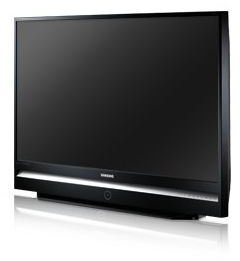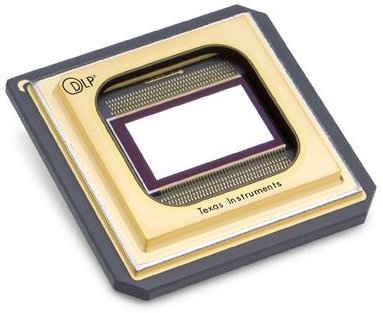What is DLP TV?
It’s the Mirrors…
Digital Light Processing (DLP) is a technology trademark owned by Texas Instruments. It was invented in 1987 and is used in standalone projectors and rear projection televisions. DLP is also the technology largely used in high definition cinema projection. In DLP projectors, the image is created by microscopic mirrors laid out in a matrix on a semiconductor chip, known as a Digital Micromirror Device. Each mirror represents a number of pixels in the final image to be projected.
Unlike LCD screens, which literally turn the pixels on and off to produce black and white, projection screens reposition the microscopic mirrors to reflect light onto a heat sink or light dump, as it is sometimes called. These minute alterations in the angle of reflection are how DLP produces grayscale images.
All the Pretty Colors
To create a color image, there are two primary methods used by DLP projection systems. There are those utilized by single-chip DLP projectors, and those used by three-chip projectors. Single-chip systems produce color either by placing a color wheel between the light source and the DLP chip or by using individual light sources for each primary color, such as LEDs.
In a three-chip DLP system, a prism is used to split the light from the lamp and each primary color is directed to its own DLP lamp, then recombined and routed through the lens, which magnifies the image.
There are arguments existing to the credit of both three-chip and single-chip systems, but suffice it to say that either system is capable of producing a brilliant spectrum of colors, potentially up to 35 trillion with a three-chip system.
Lights On!
Mainly, the light source for rear projection DLP televisions is a replaceable high-pressure mercury-vapor metal halide arc lamp unit. This is a fancy name for a very expensive bulb. As the lamp gets older and used, its electrodes wear out and its light output declines while waste heating of the lamp increases. An LED on the unit or an onscreen warning typically indicates the lamp’s end of life. Generally running about $99 - $350, approximately every one to three years, a replacement lamp is still a lot less spendy than a new TV.
Due to the replacement cost of the mercury bulbs, the long lifespan of LED technology is becoming increasingly popular. Ordinary LED technology does not produce the intensity and high lumen output characteristics required to replace arc lamps. In particular, Samsung has embraced LED projection lighting and uses it in many models, including the 61" HL61A750 and 67" HL67A750 varieties.

Pros and Cons
PROS:
- Full 1080p resolution, with smooth, waverless images
- Generally great contrast ratios (10,000:1)
- No possibility of phosphor burn-in.
- Smaller footprint than CRT.
- Least expensive HDTV technology.
- Replaceable light source. (also a con)
- Lighter and less power than LCD, CRT, or Plasma.
- No color decay (yellowing of colors with extended use of LCD).
CONS:
- Not as thin as LCD or plasma flat-panel displays. (Although getting thinner, with some wall-mountable models)
- Replacement of the lamp / light bulb. After replacing the bulb a few times, the cost can easily exceed the original purchase price of the television itself. Newer generations use LED to eliminate that issue, although there is still the potential for replacement of the LED over time.
- Some devices may have fan noise.
- Slow upscaling of last-generation video games, due to upscaling lag. All HDTV’s experience some delay in upscaling, but DLP is particularly noted to have slower response times. Next-gen consoles such as PS3 and Xbox 360 do not have this issue.
